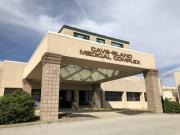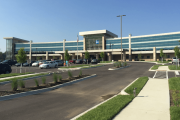Brain Cancer
If you’re diagnosed with brain cancer, you probably have a lot of questions. But you aren’t alone. Our care team will work with you to answer your questions — and together across different medical specialties — to develop a treatment plan personalized to your specific diagnosis, individual preferences and overall health goals.

As an accredited Comprehensive Community Cancer Program, we offer nearly all the same options and technology you’d find at an academic medical center, just close to home. We also treat your cancer holistically, caring not just for your physical health, but your mental and emotional health, too.
What is Brain Cancer?
Brain cancer develops when abnormal cells in the brain or spinal cord grow out of control. Unlike other types of cancer, tumors that start in the brain or spinal cord (called primary brain tumors) rarely spread to distant organs. Yet even benign (noncancerous) tumors in the brain and spinal cord can cause damage since they can press on and destroy normal brain tissue as they grow.
In adults, secondary brain tumors that start in another part of the body and then spread to the brain or spinal cord are more common than primary brain tumors. Tumors in the brain and spinal cord are treated differently depending on where they began.
Brain Cancer Symptoms
Depending on where they start in the brain or spinal cord and how fast they grow, tumors may cause different symptoms:
- Spinal cord tumors can cause bladder or bowel problems, lack of coordination and weakness or numbness.
- Tumors in the cerebellum (the back part of the brain) can cause changes in speech rhythm and difficulty swallowing and/or walking.
- Tumors in the cerebrum (the outer part of the brain) can cause problems with speech and weakness or numbness on one side of the body.
No matter where they start, tumors can put pressure on the inside of the skull, called intracranial pressure, which can lead to headaches. In fact, headaches that get worse over time are one of the most common symptoms of a brain tumor.
Other symptoms of brain cancer may include:
- Balance problems
- Blurred vision
- Drowsiness
- Nausea
- Seizures
- Vomiting
Of course, these symptoms may also be caused by other, less serious conditions. Only a doctor can determine the cause.
Brain Cancer Risk Factors
A risk factor is something that raises your risk for developing a certain type of cancer. Some, like those related to genetics, you can’t change. But others, like risk factors related to lifestyle, you can.
Most brain tumors aren’t associated with a known risk factor, but there are a few things that can raise your risk of developing this type of cancer, including:
- Certain disorders, such as neurofibromatosis type 1 (also known as von Recklinghausen disease), Von Hippel-Lindau syndrome and Li-Fraumeni syndrome
- Family history of brain tumors
- Radiation exposure, including past radiation treatments for a previous brain cancer
- Weakened immune system
Brain Cancer Types
There are more than 120 different types of brain tumors. Some are slow-growing and benign, and others are fast-growing and malignant (likely to spread).
Primary brain tumors are categorized by where they develop in the brain, which may mean the type of cell where they form. For example, gliomas begin in the glial (supportive) cells that surround neurons.
Gliomas include:
- Astrocytomas, which spread throughout the brain, blend in with normal brain tissue, making them difficult to remove with surgery.
- Ependymomas grow in the ventricles or spinal cords in adults. While they often spread along the cerebrospinal fluid (CSF) pathways, they typically don’t spread outside the brain or spinal cord.
- Oligodendrogliomas tend to grow slowly, but most of them grow into nearby brain tissue and can’t be removed completely by surgery.
Other types of brain and spinal cord tumors include:
- Craniopharyngiomas typically start above the pituitary gland and most often are considered slow growing.
- Gangliogliomas contain both neurons and glial cells and are generally slow growing.
- Medulloblastomas develop from neuroectodermal cells (early forms of nerve cells) in the cerebellum. Typically considered fast-growing tumors, they can spread throughout the CSF pathways.
- Meningiomas begin in the meninges, which are the layers of tissue that surround the outer part of the brain and spinal cord.
- Schwannomas, which are usually benign, develop from Schwann cells, which surround the cranial and other nerves.
Diagnosing Brain Cancer
Most brain and spinal cord tumors are discovered because of a worsening or persistent symptom, such as persistent and severe headache. If your doctor suspects a brain or spinal cord tumor, they may recommend a medical history and physical exam. They also may check your brain and spinal cord function by testing your reflexes, coordination and vision.
Often, we’ll order an MRI to look for a brain tumor. And for brain and spinal cord tumors, we may use special types of MRI, such as:
- Functional MRI (fMRI), which looks for tiny blood flow changes in the brain.
- Magnetic resonance angiography (MRA) and magnetic resonance venography (MRV), which look at the blood vessels in the brain.
- Magnetic resonance perfusion (perfusion MRI), which looks at the amount of blood going through different parts of the brain.
- Magnetic resonance spectroscopy (MRS), which measures biochemical changes in a certain part of the brain.
We also may use a CT scan in certain cases, including when an MRI isn’t an option.
If imaging tests indicate the presence of a tumor, we’ll use a biopsy to determine its type. We also may order a lumbar puncture (spinal tap) to look for cancer cells in the spinal fluid.
Treating Brain Cancer
If you’re diagnosed with a brain or spinal cord tumor, your care team may include a neurologist who specializes in treating diseases of the nervous system. Your team also may include a medical oncologist, radiation oncologist and surgical oncologist, as well as a dietitian, genetic counselor and nurse practitioner.
Treatment for brain and spinal cord tumors largely depends on the type of tumor, where it develops and how fast it spreads. Your care team will create a treatment plan for your individual case, based on the latest research, to help you achieve the best outcome.
These are some of the types of treatments we may recommend:
- Chemotherapy. Because of the blood-brain barrier — the inner lining of small blood vessels in the brain and spinal cord that create a divide between the blood and tissues of the central nervous system — many chemotherapy drugs are unable to enter the brain to reach cancer cells. In some cases, such as in faster-growing tumors, we may recommend injecting chemotherapy drugs directly into the CSF. Most often, though, we’ll propose chemotherapy in combination with other treatments, such as surgery and radiation therapy.
- Radiation therapy. We may recommend radiation therapy after surgery to kill any remaining cancer cells. We also may use it if surgery isn’t a good option for your tumor type or as a therapy to relieve symptoms.
- Surgery. Most of the time, a surgeon will remove as much of the tumor as they can without affecting normal brain function. Certain types of brain and spinal cord tumors respond well to surgery and may be controlled or eliminated entirely with this treatment. These tumors include slow-growing astrocytomas, ependymomas, craniopharyngiomas, gangliogliomas and meningiomas. We also may use surgery to relieve some of the symptoms caused by tumors.
In addition, we may prescribe certain medications to help lessen symptoms caused by the disease or its treatment. These may include corticosteroids, which may help relieve headaches, and anti-seizure drugs, which may help reduce the risk of seizures.

















